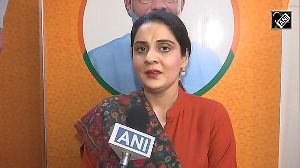Vineet Nigam, Assistant General Manager, ICRA
The recent spurt in investment proposals in certain sectors such as automobiles, telecom and consumer durables manufacturing is certainly a cause for cheer.
But we also have to look at the future demand scenario to see if the investments will actually pay off resulting in a win-win situation both for the companies and the consumers.
However, any generalisation that India Inc is over-investing, can be odious. The dynamics and the growth outlook for different sectors vary.
Let's take the example of a high consumer involvement category like consumer durables. The demand for consumer durables is both seasonal and cyclical.
In a year, peak demand for colour TVs is in the festival months of October-November. In addition, sporting events such as cricket and football world cups result in significant sales increase.
For instance, around 19.5 per cent of the total CTV sales in the country happened during the festive season last year.
The delicensing of investment in durable goods and the easing of control of the import of parts for durables led to a boom in investment for production in the sector, culminating in a 26 per cent growth in the index of industrial production for consumer durables in 1996.
However, the sector grew at only 4.6 per cent during 1997, indicating that a significant amount of pent-up demand had been met. The production picked up again from 2000 to 2002 before declining in 2003, reflecting weak demand, especially in the rural areas.
As it is, the consumer durables sector currently is characterised by overcapacity. Airconditioner maker Hitachi has a capacity of 150,000 units but its production in the past 12 months was 105,500 ACs.
One of the leading players in the market, Whirlpool of India, has a refrigerator capacity of 1.45 million but produced just 851,000 units; its washing machines manufacturing capacity is 400,000 but it makes just 240,000 units.
MIRC Electronics recently increased its CTV production capacity to 1.8 million units, but manufactures just 561,000 CTVs. The overall capacity utilisation in the sector is just around 60 per cent, which makes capacity addition futile.
Korean players such as LG and Samsung will probably have to go on an investment overdrive, since they never really had any large captive production.
With their sales increasing, they will look at moving away from production outsourcing to setting up their own manufacturing capabilities.
Also, the investment could go into newer categories such as mobile handsets or microwaves, sectors where they would want to increase their presence.
Already, there are signs that demand for durables this year may not be as good as it was in 2003. And the trend is likely to continue in 2005-06 as well.
The net margins for both white goods and consumer electronics have been declining consistently over the years. For consumer electronics, net margins decreased from 3.9 per cent in 1999 to 0.9 per cent in 2003-04 and for white goods, it is currently minus 12 per cent.
Therefore, when the industry talks of having a total colour picture tube capacity of 25 million by 2010, one fears the prospect of heavy over-capacity, because domestic demand for CTVs is estimated to be around only 17-18 million by then.
With a much larger base, the industry cannot hope to replicate the high growth rates witnessed during the early- and mid-1990s. So, the key to success may not be ramping up of capacity but looking at broadening distribution networks and getting access to proven international technology to deliver better products.
Companies in India need to improve upon the current operating efficiencies to counter cut-throat competition, price erosion and diminishing brand pull.
B Hariharan, Group Director, Finance, Bilt
To realise that there is no over-investment in manufacturing in India, one has only to compare the composition of GDP of the Chinese and Indian economies. In China, manufacturing is the driver of growth, contributing 36 per cent of GDP while services contributes 32.4 per cent.
In sharp contrast, services is the growth driver in India, contributing over 50 per cent, while manufacturing lags behind even agriculture, contributing just 16 per cent.
In most high-growth economies, the share of manufacturing in GDP is far greater compared to that of India. Manufacturing has so far missed the opportunity to drive India's overall economic development.
What is worse is that manpower employed in the manufacturing sector has remained stagnant at 10 to 11 per cent.
If India has to grow faster and create jobs for the millions joining the workforce every year, manufacturing must be pushed to grow at over 10 per cent a year, become globally competitive, and increase its productivity.
The automobile industry is already a trailblazer. Until 1983, high tariff walls, a ban on foreign investment and skewed taxation policies allowed two automakers -- Premier Automobiles and Hindustan Motors -- to produce just two car models with antiquated technology and sell about 30,000 cars every year at unaffordably-high prices.
The entry of Suzuki through a joint venture with the government, favourable taxation and tariff policies vastly expanded the market for passenger cars leading to a CAGR of 25 per cent from 1983 to 1990.
In 1992, the government lifted the remaining barriers to investment. Nine additional foreign carmakers set up manufacturing facilities. Demand for new, cheaper and fuel-efficient cars soared so that employment rose 11 per cent and productivity increased 256 per cent from 1992-93 to 1999-2000.
India now produces nearly a million cars and is one of the fastest growing automobile markets. Exports of auto components have crossed the $ 1 billion mark as foreign carmakers are flocking to source components from India.
In the process, India has managed to spawn a number of companies -- Sundaram Fasteners and Bharat Forge are the most well-known -- that can compete with the best in Europe and the US.
The success in the automotive industry can be extended to other sectors, too. India enjoys cost advantages in products ranging from two-wheelers to textiles, pharmaceuticals to electronic equipment, toothpastes and laminated tubes.
Hindustan Lever, for instance, has shown that for toothpaste manufacturing, the capital cost in India is 35 per cent and conversion cost is 15 per cent of that in Europe. While China may be good for mass production, India can offer engineering and design in addition to manufacturing.
Tecumseh has actually chosen India over China to manufacture rotary compressors. Flextronics, the world's largest electronics contract manufacturer, is ramping up facilities in India.
However, if investment is to flow into manufacturing and it is to contribute 25 per cent of GDP as against the present 16 per cent, reforms across the board are required.
Inspector raj will have to be abolished; labour laws have to be made simple and more flexible; preferences and reservations for small-scale industry have to be abolished; tariffs levels will need to be cut to an average 10 per cent; the cascading effect of state and central taxes will have to be reduced; manufacturing will have to be assured uninterrupted and reliable power supply; and road and port infrastructure will have to be drastically improved.
For its part, Indian industry will have to improve labour and capital productivity; increase spending on research and development; and improve operating efficiencies.





 © 2025
© 2025